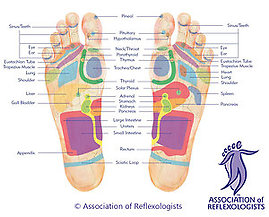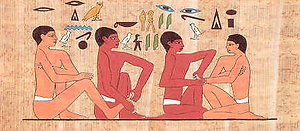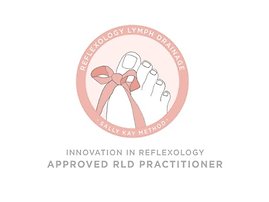Definitely not a foot rub - then what is reflexology?
Reflexology has been around for thousands of years and was practiced by ancient civilisation. The ancient cultures of India, China, Egypt and the Americas have been using different well being practices such as reflexology, yoga, meditation, acupuncture, massage etc. to stay well. In China for example reflexology parlours abound still to this day.
Reflexology was rediscovered in the Western World about 100 years ago. Through Eunice Ingham’s dedicated research and hard work her foot theory was developed and made known both amongst medical professionals and laymen.
"If you are feeling out of kilter, don’t know why or what about, let your feet reveal the answer, find the sore spot, work it out.” - Eunice Ingham
Unfortunately nowdays people in the Western world turn to complementary therapies only when things go wrong. But with a regular health maintenance programme - that includes healthy diet, regular exercise and any form of stress management, such as regular Reflexology sessions - our lives could be much healthier for longer.
Reflexology is a non-invasive, drug free, natural complementary therapy that is safe for all ages.
During the treatment more than 7000 nerve endings are stimulated in the feet! The special thumb and finger techniques used stimulate the nervous communication and improve blood and lymph circulation throughout the whole body. As a result every single cell of the body will get a better supply of oxygen and nutrients. With this intent the negative emotional and physiological effects of stress are alleviated.
You will find yourself in a deep state of relaxation where the body’s innate healing power will be able to kick in and start restoring balance.
Reflexology works on a holistic basis – in other words it works on the overall health of the person rather than a particular symptom. It rebalances and resets your entire being – physically, mentally and emotionally.

So what are the benefits?
Reflexology is a great stress buster! In this fast paced world full of endless challenges, stress dominates our lives – sometimes even without us realising it! Unfortunately it brings about unwelcome changes in our physical/mental and emotional health. Sooner or later this life style takes toll on our health.
Reflexology may very well be able to help you if you are experiencing symptoms that are related to stress including but not limited to: hormonal imbalances, aches and pains, fatigue, sleep problems, digestive issues, tension etc. Or you may simply would like to just detox and look after your own well-being.
Medical professionals agree that about 75%of our ill-health is stress related.
Therefore it is very important that we take responsibility for our own healthcare needs.
The good news is that we can take action. For example by receiving regular reflexology treatments.
Here is a list of potential benefits:
- - as no.1. it brings the mind-body into a deep state of relaxation which is a requisite for the body to do the necessary repair work
- - it creates a sense of well-being by eliminating tension
- - it reduces stress
- - improves mood
- - melts anxiety
- - promotes better sleep
- - increases energy levels
- - stimulates blood circulation
- - stimulates lymph circulation and may help reduce swelling
- - detoxifies
- - aids digestion and bowel movement
- - stronger immune system
- - deeper sense of harmony
- - may help lengthen and improve pain tolerance
- - better nervous communication throughout the body
- - may improve symptoms of peripheral neuropathy
- - aids the body to achieve the best possible recovery after an illness
However it is not just a remedial therapy but should form an important part of preventative medicine along with regular exercise, healthy nutrition and stress management.
N.B. Reflexologists do not claim to diagnose, cure nor prescribe.
A session lasts for about an hour. For information on pricing please click here.
Is it for me?
The only way to find out if reflexology can help you is to try it!
Foot, hand or facial reflexology?
If you don't like your feet being touched or feel embarrassed about them - well, there is a solution: why don’t I work on your hands or even better on your face!
Hand reflexology is very similar to reflexology done on the feet.
The Vietnamese style facial reflexology, that I practice, is very gentle. It involves a little bit of oil spread on your face to allow for a smooth glide of my fingers and the crystals I use.
But really there is no need to feel embarrassed by your feet. I have seen and worked on many different feet and I must say since I embarked on this path I haven’t looked at feet the same way as before. They are absolutely amazing! Just think about it, they do all the hard work for you all day…..and what do they get, if they are lucky a little rub here and there. So please let me show you that they deserve a little TLC and they will repay you for it!
What happens in a reflexology session?
A session generally takes about an hour. It is drug free, non-invasive and safe for all ages.
Before the first session a confidential medical consultation will take place also covering the life style you live. You’ll be asked to sign a consent form to express your agreement to the treatment. All confidential information is stored securely.
As only your feet will be worked on there is no need to remove any clothing, only your shoes and socks. If the feet cannot be worked on the hands will do too.
You’ll be seated on a reclining chair and covered by a warm blanket to maintain a comfortable body temperature. Your feet will be first cleansed and warmed up by some massage techniques. This will be followed by the actual reflexology treatment consisting specific thumb, finger and knuckle pressure techniques that are adapted to your individual needs. It should not tickle or be painful however some discomfort might be felt. The whole treatment should feel deeply relaxing.
A professionally trained reflexologist can detect subtle changes in specific points on the feet, and by working on these points may affect the corresponding organ or system of the body.
Every treatment is tailored to individual needs according to the presenting conditions on the day. The treatment is given and then with the help of this deep state of relaxation achieved the mind-body itself will decide what to do with it and how to use it to its own advantage.
How will I feel after a session?
After the first couple of sessions of deep relaxation you may find that your sense of wellbeing has improved and you feel full of energy. However it is not unusual to experience healing reactions - such as tiredness, needing the bathroom more often, headaches, excessive sweating, your aches and pains become more troublesome etc. These should pass within 24-48 hours. They are a good sign that your body has the necessary vitality to throw off the toxins that were released into the blood stream during the treatment. These healing reactions will become less and less noticeable and eventually as your health improves thanks to reflexology treatments you will feel full of energy, will sleep better and will notice a feeling of improved mood and general wellbeing.
Aftercare advice
It is recommended to drink plenty water after each treatment to help the kidneys flush out these toxins and to take it easy for the rest of the day if you are feeling tired.
To maximise the benefits of each session I encourage you to give me any feedback you may have during and following the sessions.
How many treatments do I need?
It is the cumulative effect that sees results. Just like one doesn’t get an abdominal six pack by going to the gym only once.
For an acute condition a course of 4 one-hour treatments are recommended at weekly intervals. During these treatments the deep state of relaxation will ensure that the body reaches its maximum innate healing potential to rebalance itself. Once this optimal state is achieved treatments can become more spaced out.
For chronic conditions the length of a session, the frequency and the length of the course of treatments may be different depending on many factors, primarily on how long this chronic condition has been presenting itself and how your body reacts to treatment.
N.B. It is possible to have the treatments less frequently than every week from the start, but it will take longer to achieve good results.
Back to the top of this page



